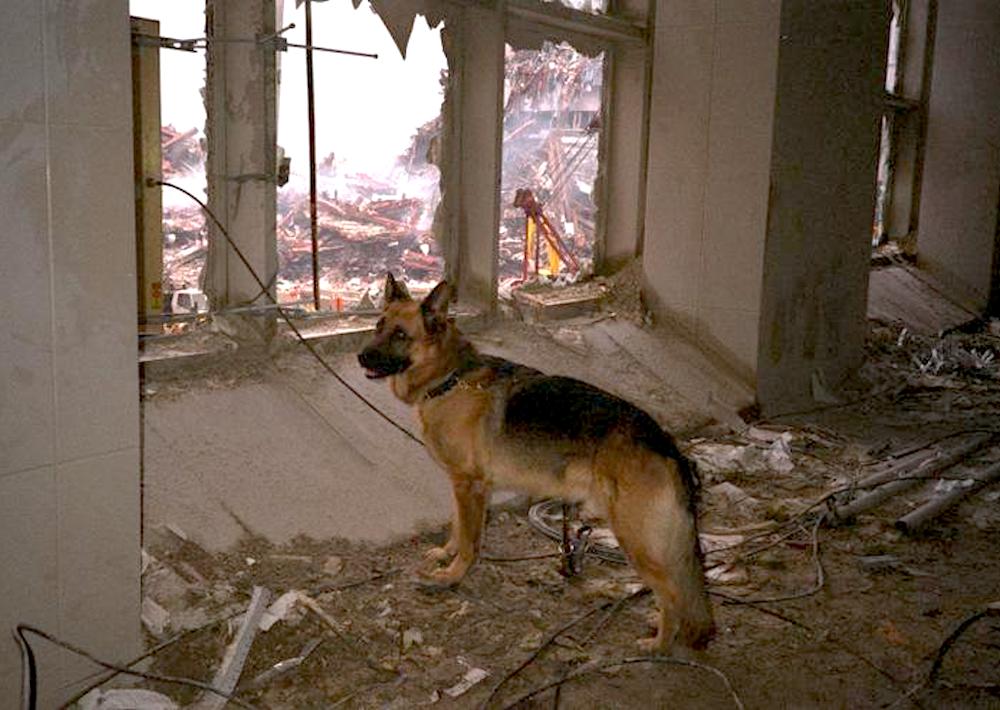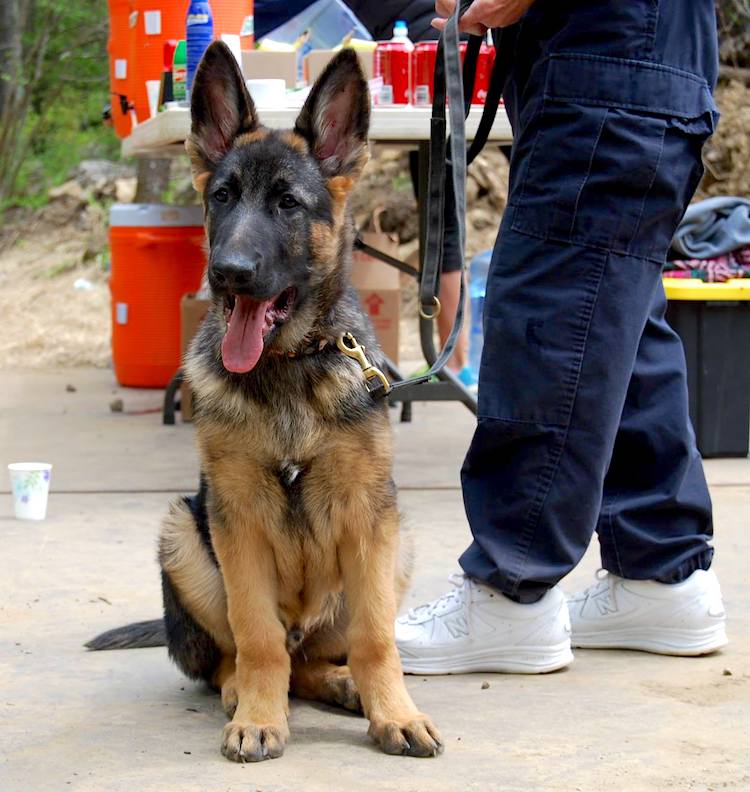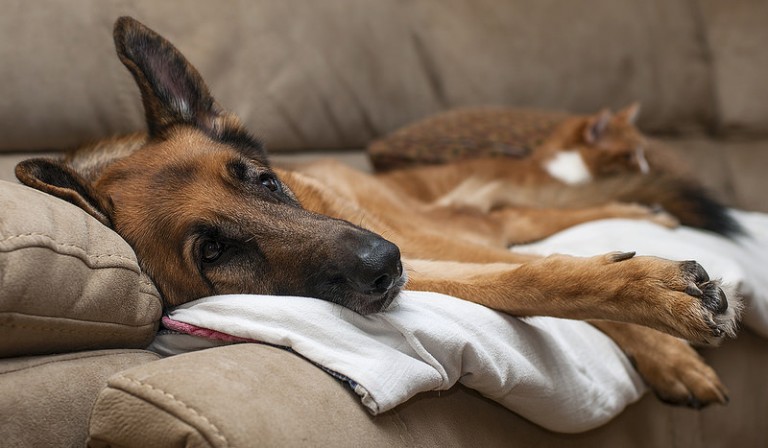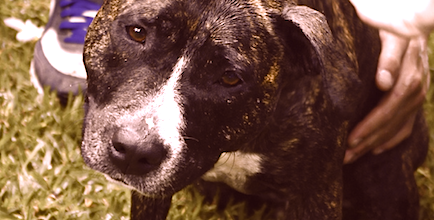The Amazing Work of Search and Rescue Dogs and Their Handlers
Years ago, dogs simply tracked trails. Today, they’re being trained in “air scenting.” Here’s how this new technique has revolutionized search and rescue.

The man had been missing for 5 days by the time Penny Sullivan and her search and rescue dog arrived on the scene in Orangetown, New York.
The last time anyone had seen him, Sullivan was told, was when he drove away in his car and headed to the barbershop for a trim before his family arrived to celebrate Mother’s Day. He never came home.
The family posted missing-person signs and searched on their own. It wasn’t until surveyors working behind the man’s house found his car in the woods with one door open and one of his shoes lying next to it that they called in the dogs.
Sullivan is president of Ramapo Rescue Dog Association, a volunteer organization that uses air-scenting German Shepherd Dogs to help locate missing people. She started her dog working the wooded area bordering a railroad track.
“We didn’t have any maps — we didn’t have anything,” she recalls in an interview with Petful.
Sullivan walked 1,000 feet or more down the railroad track, trying to define a search area, when she saw a chain-link fence going off into the woods that could serve as a “containment” — a place the missing person might have stopped or crossed.
She worked her dog on passes from the railroad tracks into the woods. On the second pass through dense briars and garbage, she saw her dog throw his nose up and disappear to her right. Because of the terrain, the dog was struggling to get through, and Sullivan wasn’t far behind.
“I’m fighting my way to see what the dog was interested in, and when I got around the brush and could see, the dog was nosing this blue thing on the ground,” Sullivan says.
“I’m making my way closer to him and realize it’s a sock on the foot of a man. The rest of him was wedged so tightly under the brush that all you could see was the tip of that blue sock on his foot — but he was alive.”
He was so wedged in that Sullivan, an EMT at the time, could barely reach in to check his vitals. She asked him to squeeze her hand, and he was able to do that.
He spent a number of weeks in the hospital and couldn’t remember anything after driving away from home. But he survived.
And in the world of search and rescue, that’s the best anyone can hope for.

Don’t leave your pet’s safety to chance
Sign up for Petful recall alerts today.

Air-Scenting Dogs: A Revolution in Search and Rescue
The desperate hunt for a missing little girl in Snohomish, Washington, in 1961 marked a milestone in the search and rescue movement.
The girl had gone out to play with the both of the family’s dogs, but only one dog returned.
Her parents encouraged the dog to lead them back to their child, who was found with the other dog who had stayed behind with her.
This incident had a profound effect on the search and rescue movement in the United States. Members of the German Shepherd Dog Club of Washington State, specifically dog trainers Bill and Jean Syrotuck and Hank and Janet Wilcox, became fascinated with the dog’s role in finding the missing child.
Consequently, they founded the American Rescue Dog Association (ARDA), which focused on training dogs to find missing people.
Though the original standard was tracking, meaning the dogs followed a scent on the ground, the problem with this method is that by the time tracking dogs are usually called in, the trail on the ground has dissipated.
That’s why the group began to train dogs for air scenting, meaning the dogs follow the scent of human beings that is carried on the air.
Hank Wilcox had worked with air-scenting dogs during World War II. The advantage of air scenting is that several dog teams can work different areas to pick up currents of human scent. This provides a larger search area because dogs don’t have to find the exact path where a missing person walked.
The group trained for several years, and in May 1966 they were finally able to prove their capabilities in locating a missing person.
Four hours after a 14-year-old boy had gone missing in a rural area, the dogs were called in. They found him alive within 20 minutes.
That success gave them the motivation for handlers and their dogs to work on perfecting their methods.
Four other teams that formed at that time joined the group as members of the ARDA. The goal was to provide expertly trained search and rescue dogs and handlers across the country, with the ARDA functioning as a hub to share training techniques, develop standards and certification procedures, and create a national alert system for major emergencies.
Bill Syrotuck’s research in applied physics, with an emphasis on statistical studies, formed the foundation for his work on the study of victim behavior and honed his ability to determine the “highest probability areas” to search for a missing person.
Jean Syrotuck had a degree in nursing and worked for 20 years in medical research at the University of Washington. Her specialization in environmental health, nutrition and dermatology led her to the study of skin rafts to determine how dogs find human scent.
The couple’s pioneering work on scent and its relation to the terrain and weather resulted in the air-scenting search dog techniques that are used throughout the world today.

A Dog’s Nose
Dogs largely experience the world through scent.
That’s because each dog has around 300 million olfactory receptors, while a human has only 6 million. These receptors absorb odors.
Humans shed around 40,000 tiny pieces of organic matter, called skin rafts, every minute. It is these skin rafts that carry an individual’s scent, which dogs can detect. These skin rafts are unique to every individual — even identical twins don’t have the same skin rafts.
Composed of skin, sweat, bacteria, hormones, enzymes, and inorganic substances such as perfume and soap, heavier skin rafts fall downward and stick to vegetation and the ground; lighter skin rafts are carried by air currents.
Ramapo Rescue Dog Association has performed a fascinating demonstration of dogs’ ability to discern individual human scent in schools:
- They ask a few student volunteers to take off one shoe each and put them all in a pile in the middle of the room.
- Each dog handler lets their dog sniff the remaining shoe on a student’s foot.
- The dogs then go to the center of the pile and consistently pick out the corresponding shoes.
“They were very, very good at doing that,” says Sullivan, the association’s president.

The Word Spreads
Bill Syrotuck, the man credited with launching the use of dogs in search and rescue in the United States, met Sullivan to discuss his work. That visit was the catalyst for launching the Ramapo Rescue Dog Association in 1971.
“Our unit is, to my knowledge, one of the oldest continuous K-9 search units in the United States,” Sullivan says.
Sullivan became president of ARDA after Syrotuck’s death in 1976, and she held that position for 20 years while maintaining her standing as a foundation board member at Ramapo Rescue Dog Association, where she is also an operational member with her K-9 Killian.
The nonprofit organization received a generous donation in 2015 from the estate of a New York City philanthropist who happened to love the German Shepherd breed.
That gift allowed Ramapo Rescue Dog Association to buy a 188-acre farm in Hamptonburg, 63 miles north of New York City, and establish a state-of-the-art training site for both the tri-state area law enforcement community and other search and rescue groups.
Live Find or Cadaver Dogs
Over the years, other search and rescue groups have formed, and various dog breeds have been employed to find and follow human scent.
Some groups, such as the National Disaster Search Dog Foundation, find rescue dogs in shelters and train them. They look for certain qualities rather than focus on breed.
The National Disaster Search Dog Foundation was born out of the Oklahoma City bombing.
Founder Wilma Melville was one of the FEMA-Certified Canine Search Specialists deployed to that bombing site in 1995. First responders’ responsibility was to locate anyone still alive who was buried in the rubble — and quickly.
Because of that experience, dogs trained by the National Disaster Search Dog Foundation specialize in either live finds or finding human remains.
A dog’s nose can detect an individual human, both alive and deceased. Some dogs are trained to find both. But in the National Disaster Search Dog Foundation, the dogs are trained to find only one, according to Capt. Derek Chaky of the Carrollton Fire Department on the Texas Task Force.
And there’s a good reason for that.
Two different teams of dogs preserve resources, Chaky tells Petful. His dog, Scout, is trained to find living people — and time is of the essence.
“We don’t want them alerting or even showing any interest in human remains because if they do, we might send in some rescue guys to check it out, and then you take more resources away,” Chaky says.
“There’s a fatality there, but we’re trying to cover as many structures as we can looking for live victims in a wide area disaster, and it ties up our limited resources. These canines are so hard to come by.”

Play Drive That Just Won’t Quit
Wilma Melville developed the National Disaster Search Dog Foundation as a program to take shelter dogs from across the country and train them to be rescuers.
They started out training dogs in a kennel in Northern California, but over the past few years, they were able to open a National Training Center in Santa Paula, California.
“Wilma’s vision is finally complete as far as having our own place,” says Denise Sanders, the foundation’s director of communications.
Ramapo Rescue Dog Association uses German Shepherds exclusively. “Not that other dogs can’t do it,” says Sullivan. “But the shepherd is my ideal dog for the work. As a herding breed, they can cover vast amounts of area quickly.”
Factor in their size and their double coat, which protects them from the elements, and physically, the breed is suited perfectly to the task, she says.
Sullivan also looks for temperament and drive.
“You need a dog that loves the work and will do anything for the reward, which in our case is going to be play or a food reward,” she says.
Sanders of the National Disaster Search Dog Foundation has a similar list of qualities that she looks for in dogs at shelters. The most important quality is often the very reason these dogs end up at the shelter in the first place.
“We’re looking for over-the-top toy drive,” Sanders explains, “for a dog who not only wants to play with the toy, but goes beyond that: That dog has an innate, obsessive desire to possess the toy.”
“It’s a lot to handle, and unfortunately that’s often why these dogs end up in shelters,” she says.
And again, we’re not talking about the typical high-energy pup who will play fetch in the backyard 20 times and never slow down. It’s even more than that. “These dogs will not quit,” Sanders says. “They have to be told when it’s time because they will just keep going. They have that much energy and drive.”
A dog with this kind of toy drive will be so focused on the reward that they will not be distracted by a squirrel or a bird — yet they also want to engage with their handler as well.
“That toy is enough for them, and that’s going to carry them through not just their training but through a real deployment. That toy paired with their handler is what gets them through a 3-week-plus deployment if they go internationally,” she says.
“So it’s pretty amazing what a simple toy can do, but for a dog with the right temperament and drive, it’s absolutely incredible.”

Training for Certification
At Ramapo Rescue Dog Association, most of the handlers come to the training with their own dogs, though many start working with the group when their dogs are puppies.
Handlers who bring in an older dog have usually completed basic obedience training, and the training time until they’re operational can be less than working from scratch with puppies, according to Sullivan.
“Obviously, these little guys have all kinds of skills to learn,” Sullivan says. “But then we introduce them to this game of finding people, and to the dog, it’s the best fun they ever have — and it’s with them for the rest of their lives.”
The National Disaster Search Dog Foundation has recruiters across the country who search for potential dogs. The recruiters have an evaluation process they go through in the shelter.
“Obviously, not every shelter has a rubble pile,” says Sanders. “So we do what we can. We will turn over chairs. We will get pallets if we can. We try and create a little bit of debris, so we can see if the dog is comfortable going up and over things that might be moving, or might feel funny under their feet, just to get a feel of it.”
This natural ability is important because search and rescue dogs are often working in difficult and dangerous environments. They search through mountains of rubble from earthquakes, hurricanes, tornadoes, fires, and terror attacks. A dog that is comfortable walking on surfaces that aren’t flat and may shift under their paws is a dog that trainers want to work with.
Part of the training involves teaching the dog how to locate “voids” and crawl into them to search, says Chaky.
“Sometimes they have to crawl under something, but they are a lot shorter than us, so they can make their way through it. They have 4-wheel-drive,” Chaky says. “They can get into spots that would take us a long time or where we would have to move rubble to get into.”
Even in areas that the dogs can’t get into, they can still work because of their sense of smell.
“If there is a scent of a live victim, they work the area until they can pinpoint where that scent is coming out the strongest, and then they’ll give us the alert for that,” he says.
Back at the National Training Center, the trainers can observe the new K-9 recruits on an actual rubble or pallet pile, and see how they respond when it gets a little more challenging. “It’s a constant evaluation,” says Sanders.
The team must determine if a dog’s high level of energy originates from being cooped up in a shelter for months, and they just want to run around and interact, or if that drive to play is innate and remains at a high level consistently.
However, dogs that flunk out of their training program won’t ever have to worry about being homeless again. These dogs are entered into the Lifetime Care program.
Some of them are trained for another career in fields like:
- Drug detection
- Bomb-sniffing dogs
- Service dogs for people with disabilities
- PTSD dogs for veterans

Other dogs end up becoming beloved pets in adoptive families, and the program stays in touch with the home as the dogs’ lifetime advocate.
But Sanders gets most excited when she talks about the dogs’ moment of transformation “once they realize that not only can they bark for the toy, but they are rewarded with the toy. They are barking, but they’re a good dog for doing it.”
While detection work, such as bomb-sniffing dogs, employs a passive alert like a “sit” or “down” to ensure that a dog doesn’t accidently detonate live explosives, search and rescue uses a bark alert.
“The reason for that is on a disaster site, you’re going to have equipment and people yelling,” says Sanders. “You’re going to have great distances that have to be covered. And so the bark makes the most sense as an active alert.”
The issue at first is that dogs are often discouraged from barking at shelters. They have been yelled at or even hit for barking.
“We have to be able to bring that back out of them and let them know that we want them to bark,” says Sanders. “When they bark as an alert, they get their toy, and we celebrate and act silly and use high-pitched voices because that tells the dog that not only do we want them to bark, but we love them for it.”
They use barrels that conceal one trainer’s body, with a small door that looks like a mouse hole at the bottom, which allows scent to escape.
“It’s not the whole entire face of the barrel,” says Sanders. “It’s just that little air space. The human body puts off enough scent for these dogs to find it because their noses are so amazing.”
The dogs aren’t sure what the game is at first, but they start sniffing around. “And then you will see body language: Either their tail goes up or it starts wagging, or their body gets a little stiff for just a split second as they realize, this is it!”
Initially, the dogs are rewarded when they put their nose right there where the scent is in the hole because that’s exactly what’s needed.
“Some dogs will start barking right off the bat. And we want them to bark right where that scent is because down the road, that becomes very important, that pinpointing.”
Once the dogs understand what their job is, the trainers add a few more barrels that don’t have anyone inside, keeping one barrel with a human being inside to teach them that the barrel with the human is the most important one.
The barrels will be spread out in the training area to get the dogs used to visual distraction and teach them to check out every single barrel. The dogs start to rely solely on their nose, using their eyes only to keep from running into something.
At that point, the dogs are moved to an actual rubble pile. By that time, they are so focused on the scent that the rubble doesn’t faze them. They just want to play the game and find the person so they can get their toy.
“It still gives me goosebumps to see a dog cross 10,000 square feet of rubble in 30 seconds or less and be able to pinpoint one single human being that’s underneath all of that concrete, and you hear that loud, clear bark alert,” says Sanders.
“That moment is absolutely amazing.”

Passing of the Leashes
Dogs are eventually paired with a handler when they are 8–12 months old.
The handler candidates also go through an evaluation process when they come out for 2 weeks to the foundation at the end of the dogs’ training.
“The handlers have to learn everything from scratch because they’re learning our way of doing things and our commands,” says Sanders. The majority of the handlers are firefighters, and they learn subjects that are new to them, like scent theory.
“In the first week of the 2-week course, they work with every single dog we have in training, so they’re learning about different breeds, different behaviors and different temperaments, because the dogs are very individual, just like humans,” says Sanders.
By the second week, the trainers begin to match them up so that the dogs and handlers can graduate as pairs. They observe skill levels and try to find similarities. They look for a certain chemistry between the pairs.
Sometimes that chemistry is apparent from the moment the handler picks up the leash.
“But the official ‘passing of the leashes,’ as we call it, from trainer to handler, is the Friday of the second week of the course. That’s our graduation day,” Sanders explains.
It’s a big celebration, with families, fellow firefighters, task force members and friends showing up.
“Even though the handlers and their dogs have only known each other for 2 weeks at that point, you see these dogs just looking up into their handlers’ eyes, making eye contact, leaning against them as they’re sitting on stage,” says Sanders.
“It’s really emotional to see that bond start because a lot of times when these dogs come in, they don’t connect with humans. They’ve had no reason to. Humans have never given them anything to be grateful for. But now they’re connected to this new person that will be their person for the rest of their lives.”
After that, the dog goes home with the handler, and they are together 24/7. The teams continue to train weekly on rubble to reach the high skill level needed to attain FEMA or state certification.
Deployment Readiness
Part of becoming a team involves the handler learning compass and map skills and knowing how to grid an area thoroughly, according to Sullivan.
“They are using this wonderful air-scenting Geiger counter machine on 4 legs to help them,” she says, “but they have to cover the area and know what they’re doing.”
On July 31, 2018, Derek Chaky and Scout were called out to the collapse of a parking structure.
“Four floors of a parking garage had pancaked down,” recalls Chaky. “We ended up searching the vehicles that were in the collapsed structure.”
Their job was to confirm that no one had been inside a car when the building collapsed.
This is a good example of why these dogs need so much training on rubble piles. The handlers stay in a relatively safe location while the dogs work in more treacherous areas.
Scout started searching from the top of the parking structure, checking flipped-over cars to ensure no one was inside.
“We try to keep eyes on them. Usually we can do that, but if not, they follow our verbal commands,” says Chaky.
Handlers can recall them verbally, so the dogs will return and be directed elsewhere, he says. “If they’re that far away where they can’t hear either the verbal or the whistle command, we can direct them with just our hand motions: left, right, back, or come to us. It’s called SAR directional training.”
Chaky and Scout were paired at the National Search Dog Foundation in 2014. That April, they tested and passed both certifications and were then fully deployable.
These days, Scout goes everywhere with Chaky. “Every day I go to work, he travels to the fire station with me. He’s just a member of the fire department,” the fire captain says.
Ramapo Rescue Dog Association has been involved in a number of disaster searches:
- They were at Ground Zero in New York days after 9/11.
- They worked serial killer cases and found homicide victims buried in rock walls.
- They found 150-year-old bones when a contractor unknowingly disturbed a Civil War cemetery.
- They were in Puerto Rico after mudslides.
- They worked at the Johnstown, Pennsylvania, flood of 1977.
- Sullivan worked with her dog in Armenia following a devastating earthquake in 1988.
“The dogs can be so helpful in disasters — whether it’s hurricanes, mudslides, earthquakes or bombings,” Sullivan says. “These dogs are magnificent.”







